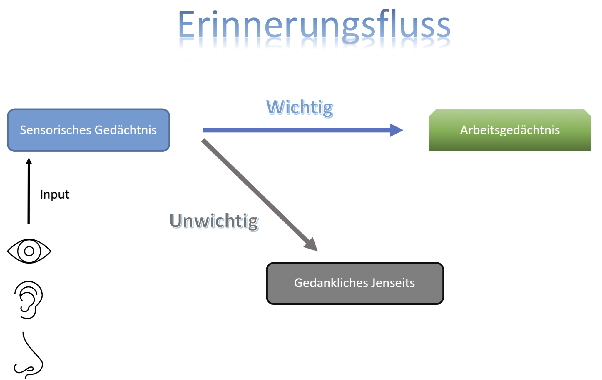Memory - A Dam for Memories
Do you have a memory like a sieve? Learn how your brain stores memories and improve your recall.
Memory - A Dam for Memories
Do you often struggle to remember important tasks? After a two-hour meeting, do you only recall vague images and snippets of conversation? Want to know why you didn't store the day as a memory? You're in the right place! We'll explain how the human brain manages and stores memories.
Information Intake
Information processing starts in the sensory or ultra-short-term memory. It holds all information our "sensors" like ears, nose, and eyes take in for just a few seconds. This is just long enough to filter the information. Most unnecessary information gets forgotten. The brain passes on what it considers important to the short-term memory.

Conscious Processing
We have conscious access and limited influence over our short-term memory.
Solving a mental math problem is an example: 13+32. Already calculated? The answer is forty-five. To reach this result, you must remember the two numbers, visualize them, and add them. This "work" happens in the short-term memory, also called working memory.
However, memories in working memory are vulnerable. If your phone rings during your calculation, you'll likely forget the numbers.
This happens because short-term memory has limited space. It can hold between five and nine thoughts. New information pushes out old information. To keep thoughts longer, you must move them to long-term memory.
Before we continue with long-term memory, a question: Can you still remember the two numbers from the math problem? If you had to scroll up, the answer is no. The author couldn't remember the numbers while writing this section either. But they did remember the result, 45.
Different thoughts are stored for varying lengths of time. The result you worked out lasts longer than the individual components that led to it.
What Lasts...
To keep very important memories for a long time, they can be moved from short-term to long-term memory. Unfortunately, this process is subconscious, and we have no direct control over it.
Long-term memory divides into two areas:
Declarative Memory
Declarative memory stores all "knowledge information." This includes math skills or a cake recipe. It holds all information that can be expressed in words.
Non-declarative Memory
Non-declarative memory stores movement patterns and routines that don't require active thinking. Natural breathing or the walking motion is stored here.

To intentionally transfer information to long-term memory, constant repetition is needed. A great example is a person's native language. A child babbles countless unclear sounds until it learns to form the tones into the language its parents speak. Once learned, these words are never forgotten. Even if not spoken for years, because the person moved abroad, they'll remember most of it. The language is ingrained in long-term memory through constant practice.
By the way, you can train your memory by constantly retrieving information from long-term memory. Continuous synapse activation strengthens nerve connections, making it easier to access stored information. Try different thinking games. But pay attention to which brain areas they target. A logic game doesn't train memory!
Learning Tip: Sleep on It
During sleep, the brain sorts the day's experiences and connects them with existing feelings and emotions.
A book read before bed is fresh in memory and easier to sort into long-term memory. If you want or need to learn something new, read it before bed for the first or repeated time. Test yourself the next morning to see if you remember it. Repeat this process for several days, and you'll find it easier to retain the learned material.
Conclusion
Our memory is fascinating. We take in information, work with it, discard unnecessary information, and store the important stuff in a seemingly endless space. And it all happens automatically, subconsciously!
If you need more tips on how to retain learned material better, check out our post on Criteria for Good Learning. You'll find tips to achieve a good learning effect for seminar participants. Apply these tips to yourself!
